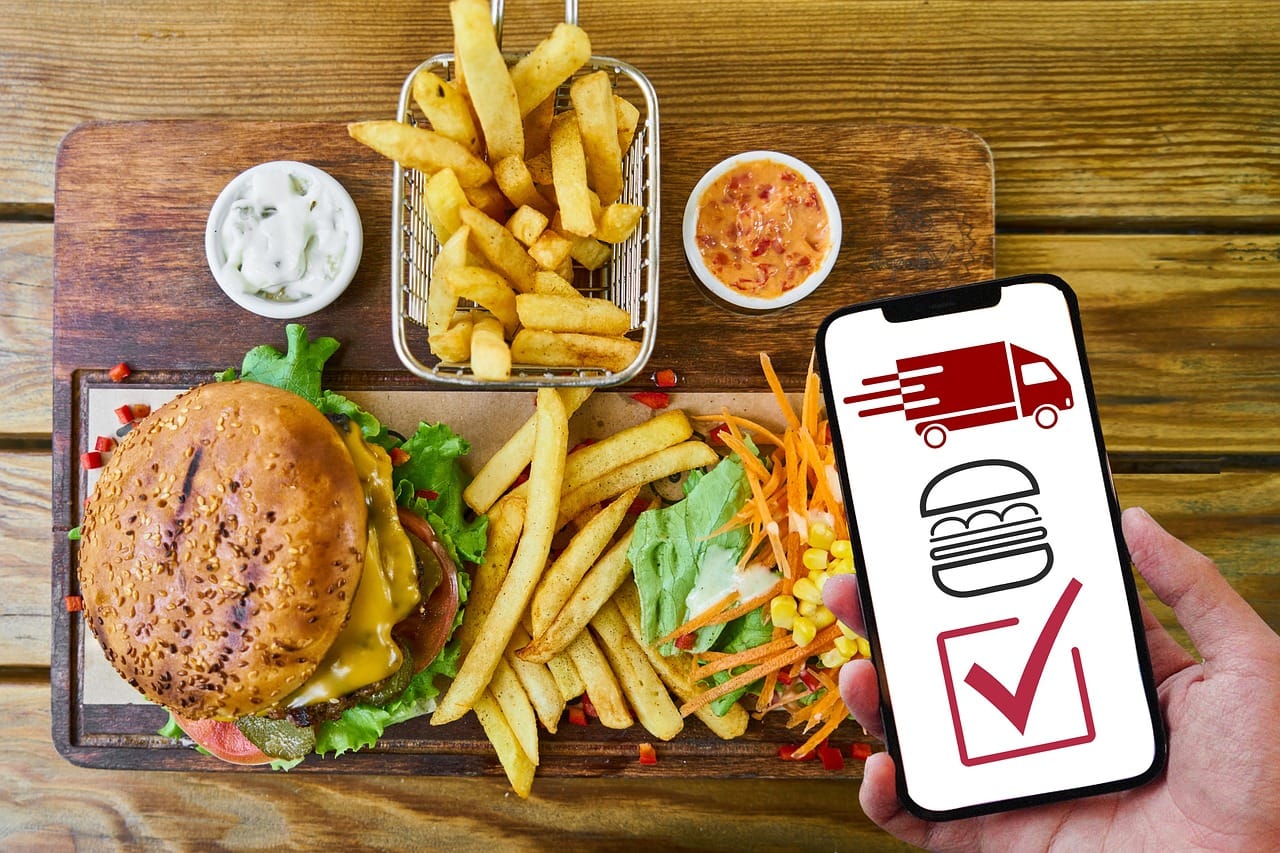Deliver with Uber Eats, complete guide to getting started

This post contains affiliate links that HyreCar may receive a commission for referring you to them.
What is Uber Eats and how does it work?
When Uber launched its food delivery service Uber Eats in 2014, the competition in the food delivery market was already fierce. Still, despite being a late mover, Uber Eats managed to stand its ground, and it hasn’t looked back since.
As of today, Uber Eats is one of the leading food delivery platforms globally, operating in 45 countries across six continents. And as the gig economy grows, so does the demand for food delivery drivers. Long story short, if you’ve been thinking about becoming an Uber Eats delivery driver, now is the best time to do it.
And if you already drive for Uber, that’s even better as you can deliver with Uber Eats, too. This service is fast and convenient for customers and offers a new revenue stream for drivers.
Uber Eats food delivery app works similarly to Instacart, Shipt, DoorDash, and Postmates in the sense that drivers deliver food or groceries. Basically, a hungry customer orders a meal from one of participating local restaurants using the Uber Eats app, or the Uber Eats website. Then, a delivery driver working for Uber picks up the take-out order and delivers it to the customer’s location.
What does it take to become a delivery driver with Uber, though? And what are the pros and cons of being one? That’s what we’ll try to explain in the following guide.
Who can drive with Uber Eats?

If you’re already an Uber, Instacart, DoorDash, or Postmates rideshare driver, signing up for Uber Eats is a breeze. If you currently drive for Uber, simply go to your account on the Uber app and select Vehicle Options. Read and accept the delivery terms. Now you can easily enable or disable the delivery option through your account whenever you want to start earning some extra cash delivering food rather than giving rides to passengers.
How to start delivering for Uber Eats?
The story is different if you don’t drive on the Uber network. In this case, you’ll need to apply to use the Uber platform to deliver food. Before you do that, however, be sure to prepare the required documents. The requirements to deliver for Uber Eats can vary by city, but there are several standard conditions one must meet to drive with Uber Eats:
- You need to be at least 19 years old
- Your 2 or 4-door car must be newer than a 1998 model
- Valid driver’s license and car insurance
- In the US, you need at least one year of driving experience
- You will need a clean driving record with no major violations dating back 7 years
- Upon applying, you will be required to pass a background check and a safety screening and upload a few required documents.
Once you’ve checked off all of these, you’re almost ready to drive for Uber Eats and make some cash. First, you’ll need to apply. Here’s a quick step-by-step guide on how to do that:
- Go to the sign-up page. Once on the Uber sign-up page, you’ll be required to fill in a standard form with your name, email address, phone number, etc.
- Select the type of transportation. Next, you’ll be asked to pick your transportation method of delivery. Pick your option and click on ‘continue.’
- Authorize background check. The next step is to authorize the standard Uber Eats background check. Browse through it and tap on ‘Agree’ to authorize it. You’ll also be asked to submit your Social Security number and read the disclosure. Mark the box next to ‘I agree and acknowledge,’ and click on ‘Submit’ to move on.
- Add your driver’s license. If you’ve chosen car delivery in the second step, you’ll need to upload your valid driver’s license. If you’ve opted for bike delivery, you’ll need to upload your photo. Once you’re done, click on ‘Go to next step.’
- Add proof of your vehicle insurance. If you’ve chosen a car or scooter delivery, you’ll be required to upload proof of your vehicle insurance. It should include your name, vehicle identification number (VIN), insurance company, and your insurance expiration date.
- Upload your vehicle registration. Next, you’ll have to upload a picture of your registration. It should include its model year, VIN, and expiration date.
- Upload your profile photo. Once you’re done uploading all the required docs, the final thing to do is upload your profile picture. It should be a well-lit headshot of your face without a hat or sunglasses.
Once you fill in the necessary forms, all left is to wait for Uber’s approval. If you meet all the Uber delivery driver requirements, you should be accepted as one of the Eats drivers within a week. However, the process may take longer depending on how many applications Uber receives.
How do you use the Uber Eats app or website?
Once you become a Uber Eats food delivery driver, you’re all set to jump right into the action. You can receive delivery requests via your Uber Driver app. Below are the basic steps for how it works – from getting the request to picking up the food to delivering the food to the customer.
Food Delivery Requests:
- You’ll receive an audio notification through the app, just like a ride request.
- Notice that the screen will say “delivery” instead of “Uber X.”
- Tap the screen to accept the delivery request.
- You’ll get info regarding the food order number, pick-up location, and customer name.
Pick-Ups:
- Tap “navigate,” and the GPS will direct you to the restaurant.
- Give the restaurant staff the food order number and customer name when you arrive.
- Double-check the order before heading back to your car with the take-out packages.
Food Deliveries:
- Tap “start trip” for directions to the delivery address.
- Swipe up in the app for special delivery instructions regarding drop-off or parking.
- The customer will receive a text as you approach, so they’re ready for you.
- Knock or ring the bell if they didn’t request to meet you outside their location.
- Greet the customer by introducing yourself with a smile and hand them their order.
- Swipe “complete trip,” and you’re done with this delivery!
Where can you download the Uber Eats app?
You’ll be able to find it in Google Play or App Store, depending on whether you have an Android or iPhone!
How much money do drivers that work for Uber Eats earn, and what is the pay structure?

Uber Eats doesn’t base payments on driving time, like regular Uber rides. According to RideSharingDriver.com, as of May 2018, the average delivery person working for Uber Eats can take home $8 to $12 an hour after subtracting vehicle expenses and Uber’s commission.
You’ll make more money if you deliver multiple orders during busy times like lunch and dinner. Boost multipliers are also available at specific times and locations in-app, which allow drivers to earn more on each trip (similar to surge pricing).
The fees you’re paid, as well as Uber’s commission, may vary depending on the city and the type of vehicle you drive (a car, motorized scooter, or bicycle). Still, the Uber Eats pay structure for drivers is based on the following equation:
A fixed driver food pick-up fee, plus miles traveled between pick-up and delivery to customer fare, plus a fixed driver food delivery fee, minus Uber’s 25% commission = Uber Eats Driver payment per completed delivery.
Here’s a typical example of the equation from the Uber help page:
$2.50 pickup + $0.20 x 5.2 miles + $3.00 drop off = $6.54 delivery fare. If Uber takes a 25% commission in your city, you end up with $4.90. Uber’s commission can be higher in some cities.
If you haven’t already, go check out our friends at Gridwise, the ultimate rideshare and delivery assistant. It’s a free app for iOS and Android that helps rideshare and food delivery drivers increase their earnings by up to 39% and save thousands on their tax bills.
Can you accept tips while delivering for Uber Eats?
Customers are not required to tip drivers, but you’re welcome to accept a tip if one is offered. You do keep 100% of all the tips you receive, whether you’re tipped in cash or the customer adds a gratuity through the Uber Eats app.
If a customer cancels their order after you’ve picked it up at the restaurant, you still get paid your pick-up and delivery fees and the estimated mileage of the delivery. Uber says you can keep the food for yourself or throw it away.
What if something goes wrong during your delivery?

Let’s face it, stuff happens, right? Like traffic, car trouble, the customer doesn’t respond when you arrive, or the restaurant messed up the order. Unexpected problems are bread and butter for any delivery driver. The key is to know how to solve them.
Here are some tips on how to handle such unpredictable issues yourself or by contacting Uber customer support:
- Problem dropping off the order? The Uber app clipboard has the customer’s contact support info, so you can text or call them.
- Problem picking up the order? The restaurant’s contact info is inside the app as well.
- If the customer does not respond or there is a serious problem, you can always contact local Uber support through the Help section of the Uber app.
What are the pros and cons of Uber Eats?
Becoming an Uber Eats delivery driver seems like a fantastic idea if you want to earn some extra bucks or you’re tired of driving people around. However, as with all decisions, there are pros and cons to driving for Uber Eats vs just plain Uber. Here are a few to keep in mind before you want to start delivering with Uber Eats:
Pros:
- Uber Eats is an easy way to make extra cash, whether you drive for Uber or not.
- Like Postmates, DoorDash, and Instacart, driving for Uber Eats means you only transport food, not people. Sometimes driving for Uber requires you to deal with drunk, rude, or unruly passengers, which isn’t the most pleasant experience.
- If you’re 19 years old, you can drive for Uber Eats. You have to be 21 to drive for UberX.
- Uber Eats has fewer vehicle restrictions than regular Uber, so most vehicles 1998 and newer will qualify, even if it only has 2 doors.
- Being an Uber Eats driver is a great gig if you love driving around town.
Cons:
- Your hourly Uber Eats pay can drop below $10 during slow delivery times. On average, most Uber drivers earn more than that hourly wage during a normal shift.
- Waiting at slow restaurants, dealing with traffic jams, searching for parking spots, and locating hard-to-find customers or delivery locations can be annoying.
Where is Uber Eats available?

Nowadays, you can become an Uber Eats food delivery driver in practically any large city across the USA. For a complete, up-to-date list of large and small cities in the USA where Uber Eats delivers, visit the Uber Eats Cities page.
Here is a shortened list of popular cities where Uber Eats delivers in the US:
- San Diego, Los Angeles, Sacramento, Spokane
- Phoenix, El Paso, St. Louis, Chicago
- Chattanooga, Boston, Dallas, Charlotte
- New York, Cleveland, Oklahoma City, Milwaukee
- New Orleans, Grand Rapids, Gainesville, Denver, Boston, and many, many more.
What to consider before becoming a food delivery driver with Uber Eats?
Once you consider all the pros and cons of working as a delivery driver using the Uber Eats app, it’s clear that it provides a fantastic opportunity to earn extra money. However, before you become one, there are several things you ought to understand first. Below, we’ve listed some of the most significant considerations to have before applying for a food delivery driver with Uber Eats:
Prepare to work long hours
Working as a food delivery driver may seem pretty straightforward at first. And true, delivering with Uber Eats is not rocket science. However, it does require working long hours, and it can be exhausting, even when driving a car.
Other than that, engaging with customers can also get tiring after a while. Not to mention you’ll need to keep track of countless delivery requests and meet your targets. With all this in mind, you have to prepare yourself physically and mentally to do your job right. The best idea here is to estimate how many hours you’ll need to work to meet your targets and payment goals and adjust your work schedule accordingly.
Being a people person is a must
Although Uber Eats delivery drivers aren’t required to engage with customers as much as rideshare drivers, you’ll still need to communicate with other people. And if you’re hoping for a tip and good review, you need to be pleasant, even after working for several hours.
As a food delivery driver, you need to enjoy talking to people, or at least know how to act you enjoy it. There will also be numerous situations where customers won’t be exactly polite. In such cases, you need to know how to react in the most pleasant way possible. Also, remember that you can always report someone if they behave disturbingly. Don’t engage in conflicts, as you’ll be the one to lose.
Your income may depend on the location
Where you deliver food plays a significant role in how much money you make. For instance, smaller towns come with fewer food orders and lower pay. On the other hand, delivering in larger cities like New York, San Francisco, or Seattle will provide you with a relatively high income.
FAQs
Below we’ve listed some of the most frequently asked questions regarding working as an Uber Eats delivery person:
What are the requirements to become a delivery driver?
You’ll need to meet several requirements before even considering becoming a Uber Eats driver. These will vary depending on the transportation method delivery you opt for, as every method has different vehicle requirements.
When deciding on the car delivery, you’ll need to:
- Meet the minimum age to drive in your city
- Have a valid driver’s license
- Have a 2-door or 4-door car (if you opt for using your vehicle)
If you decide to deliver by motorized scooter, you’ll have to:
- Be at least 19 years of age
- Have a valid driver’s license
- Have a scooter under 50cc (if you want to use your vehicle)
For foot and bike delivery, you’ll need to:
- Be at least 18 years old
- Have a government-issued ID
Besides these requirements, you’ll also have to pass a standard Uber Eats background check, which reviews your criminal and motor vehicle report.
Are there any Uber Eats discounts for drivers?
Yes, once you become an Uber Eats food delivery driver, you become eligible for several incentives and promotions. These will help you maximize your earnings, so be sure you understand how they work and how they can help you earn more money.
Can I be an Uber rideshare driver and Uber Eats delivery driver simultaneously?
Of course. What’s more, Uber encourages its drivers to deliver food. Indeed, you can receive and complete both rideshare and food delivery requests using the same app. Moreover, you can do both during the same shift to avoid any downtime during your working hours.
Which vehicles can I use to deliver food with Uber Eats?
Delivering by car is only one of many ways to deliver food with Uber Eats. Other than that, you can opt for bike deliveries or scooter deliveries. However, when it comes to driving a scooter, be sure to check whether the town you want to deliver in allows it. The same goes for delivering food on foot.
Deliver with Uber Eats and earn extra money
Uber Eats platform provides both rideshare Uber drivers and aspiring delivery people with a fantastic opportunity to earn a few extra bucks. Of course, there are numerous other food delivery apps and platforms that provide drivers with a similar chance, but considering how clear Uber Eats’ rules are, they look like the best choice among the competition.
To become a delivery driver for Uber Eats, you’ll need to submit your application and pass a standard background check. If you meet all the requirements, you’ll be able to start delivering and earn money with Uber Eats within a week! It’s a gig that provides drivers with a lot of freedom regarding how they operate. If you like being your own boss and don’t mind working long hours, becoming a delivery driver with Uber Eats is certainly worth giving a go!
Disclaimer
Actual earnings may differ and depend on factors like number of deliveries completed, time of day, location, and expenses. Hourly pay is calculated using average Dasher payouts while on delivery (from the time you accept an order until the time you drop it off) over a 90-day period and includes compensation from peak pay, tips, and other incentives.



